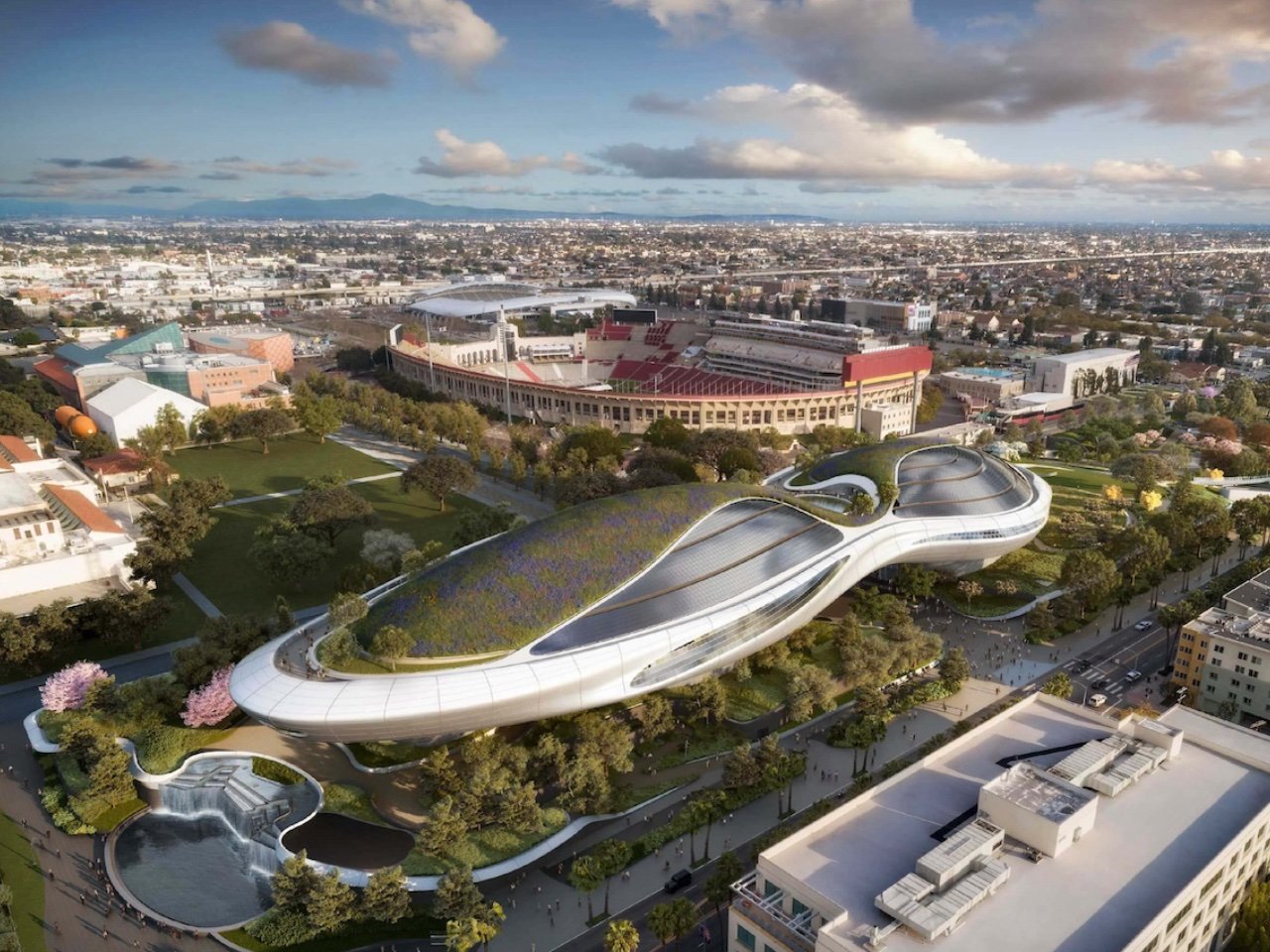When George Lucas made his first-ever Comic-Con appearance last weekend, he wasn’t there to talk about Star Wars sequels or Indiana Jones reboots. The 81-year-old filmmaker came to San Diego to show off something much more personal: his billion-dollar love letter to visual storytelling. The Lucas Museum of Narrative Art is set to open in 2026, and it’s about to change how we think about comics, illustrations, and basically every form of art that tells a story.
Designer: Ma Yansong of MAD Architects
A Building That Looks Like It Escaped From His Movies
The museum itself looks like something straight out of a Lucas film. MAD Architects designed this wild, flowing structure that seems to hover over Los Angeles’ Exposition Park like a massive spaceship. The building’s curves and organic shapes make it look alive, almost breathing. You know how Lucas always loved pushing boundaries with special effects? Well, this building does the same thing for architecture.
The 300,000-square-foot space sits on an 11-acre campus that includes two theaters, a library, restaurant, and community spaces. But here’s the cool part: the landscape design creates artificial hills, canyons, and groves right above the parking garage. They used hidden foam to shape the terrain, basically building a whole new topography from scratch. The gardens will be free and open to everyone, even if you don’t buy a museum ticket.
Construction photos from this summer show the building nearing completion. Those sculptural canopies and flowing exterior walls are taking their final shape. After more than a decade of planning and delays, Lucas is finally ready to open his doors in 2026.
What really gets me excited about this project isn’t just the futuristic architecture. It’s how Lucas is treating comic books and illustrations with the same respect traditionally reserved for oil paintings and marble sculptures. The museum’s collection includes works by comic legend Jack Kirby alongside pieces by Norman Rockwell and contemporary artist Kadir Nelson. That’s not an accident.
For too long, museums have acted like there’s some invisible hierarchy between “high art” and “popular art.” Comics get stuck in the basement while paintings hang in the main galleries. Lucas is basically saying that’s nonsense. A Jack Kirby comic panel can be just as meaningful and technically accomplished as any gallery piece. The museum defines narrative art as work that tells stories and captures universal cultural truths. That definition covers everything from ancient cave paintings to modern graphic novels.
During his Comic-Con presentation, Lucas showed preview footage that jumped seamlessly between traditional fine art and comic strips, between Star Wars sculptures and historical illustrations. The message was crystal clear: it’s all art, and it all matters.
This isn’t just a Star Wars shrine, though Lucas will certainly display his extensive archive of models, props, and costumes. He’s been collecting narrative art for over 50 years, building a collection that spans cultures and centuries. Instead of selling it off, he decided to create this public institution. “I love all art, no matter what it is,” Lucas said at Comic-Con, and you could tell he meant it.
Filmmaker Guillermo del Toro, who serves on the museum’s board, talked about how the institution offers “a visual past that belongs to everyone.” He’s even considering moving some of his personal collection there. When directors like del Toro are willing to entrust their art to your museum, you know you’re doing something right.
The timing couldn’t be better. We’re living through an explosion of visual storytelling, from graphic novels to digital art to interactive media. Traditional art institutions have been slow to embrace these new forms. Meanwhile, Lucas is creating a framework that can accommodate whatever comes next in visual storytelling technology.
Why This Matters Beyond the Art Scene
What Lucas is really creating here is more than just another museum. He calls it “a temple to the people’s art,” and that phrase captures something important. This isn’t about celebrating obscure masterpieces that only art historians understand. It’s about recognizing the visual stories that actually shape how people see the world.
Think about it: more people have probably been influenced by comic books than by most paintings hanging in traditional museums. Yet which one gets taken seriously by cultural institutions? Lucas is flipping that script entirely.
The museum also positions itself as an anthropological institution, not just an art museum. This approach recognizes that narrative art isn’t just about aesthetics. It’s about how humans communicate across cultures and generations. A medieval illuminated manuscript and a modern graphic novel are doing the same fundamental thing: using images to tell stories that matter to people.
The educational mission extends beyond the building itself through that incredible landscape design. By creating free public spaces for community gathering, Lucas is showing how cultural institutions can serve their neighborhoods in new ways. The integration of architecture, landscape, and programming represents a fresh model for how museums can operate in the 21st century.
For anyone who’s ever had to defend comics as “real art” or explain why illustration matters, this museum represents validation on the grandest possible scale. Lucas is putting his money where his mouth is, creating a billion-dollar institution that treats visual storytelling as seriously as any other art form.
The Lucas Museum of Narrative Art opens its doors in 2026, and I honestly can’t wait to see how it changes the conversation around art and storytelling. When one of the most successful filmmakers in history decides to spend his fortune celebrating the art of visual narrative, you know something important is happening. Comics, illustrations, and all forms of visual storytelling are finally getting the respect they deserve.
Key Details:
Opening: 2026
Location: Exposition Park, Los Angeles
Size: 300,000 square feet on 11-acre campus
Architect: Ma Yansong/MAD Architects
Landscape: Mia Lehrer + Associates
Cost: Estimated over $1 billion
The post George Lucas’ Sci-Fi Museum Is Finally Treating Comics Like the Art They Are first appeared on Yanko Design.

